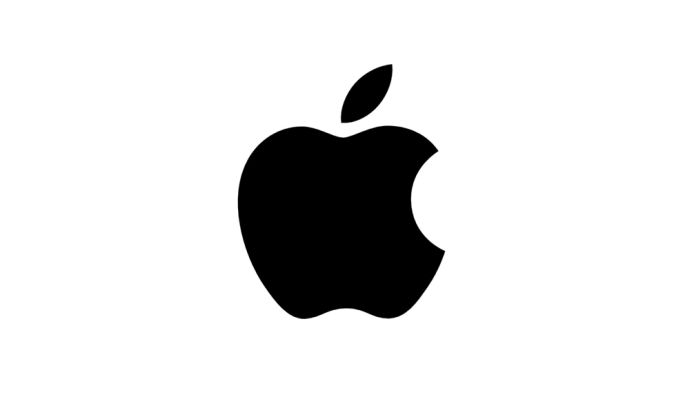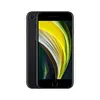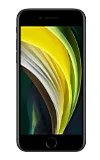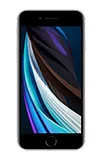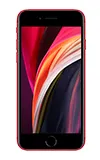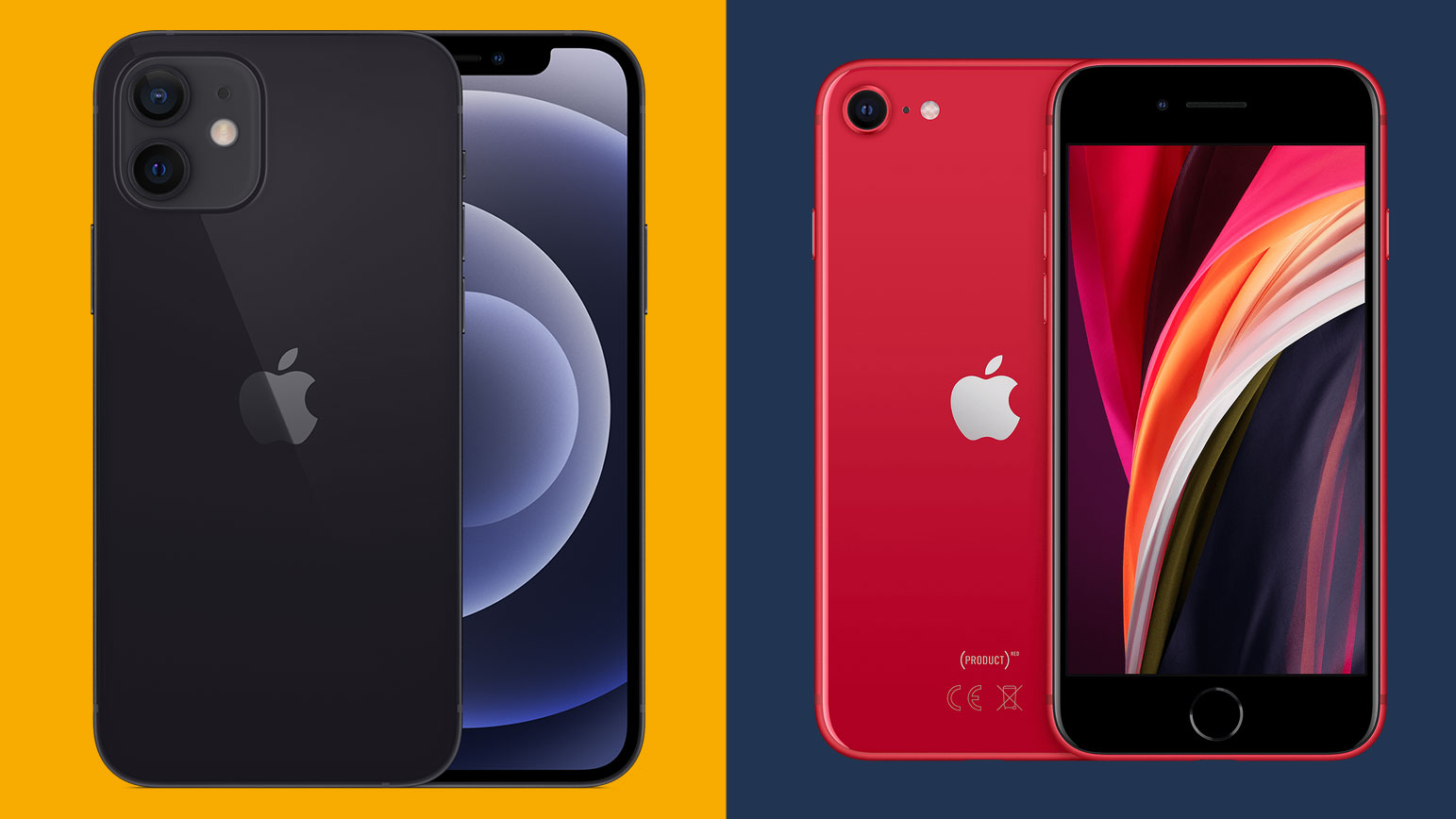
The iPhone 12 is Apple’s smartphone standard bearer for 2021, and the phone that will tick the most boxes for the most people. But it’s not for everyone.
As we noted in our review, the iPhone 12 is more expensive than its predecessor the iPhone 11, which was hardly cheap itself. There are some, too, who will lament Apple’s continued move towards ever larger displays.
For those who are operating on a strict budget, or who simply prefer the compact iPhone designs of yesteryear, there’s the iPhone SE (2020). Having launched in the same year as the iPhone 12, it’s scarcely any older, and it’s still being offered as new.
Here’s how this odd smartphone couple match up.
iPhone 12 vs iPhone SE (2020) price and availability
The iPhone 12 landed in shops on October 23, 2020. Prices kicked off at $799 / £799 / AU$1,349 for the 64GB model, and progressed up to $849 / £849 / AU$1,429 for 128GB and $949 / £949 / AU$1,599 for 256GB.
The 64GB iPhone SE 2020 launched on April 24, 2020 for $399 / £419 / AU$749. That price increases to $449 / £469 / AU$829 for 128GB and $549 / £569 / AU$999 for 256GB.
It’s still available as new from Apple, with the only change being a slightly reduced £399 / £449 / £549 price tag for UK customers.
Get daily insight, inspiration and deals in your inbox
Sign up for breaking news, reviews, opinion, top tech deals, and more.
Design
If you were unfamiliar with Apple’s work, you would never guess that these two phones were released in the same year and by the same company. That’s because their designs are from completely different eras.
The iPhone SE (2020) is externally nigh-on identical to the 2017 iPhone 8, which makes it seem dated. When you consider that the basic blueprint for the shape, size and lay-out of this phone was laid down with the 2014 iPhone 6, it seems positively ancient.
Not that the SE feels anything but classy in the hand. With glass to the front and rear and a rounded aluminum chassis, and with Apple’s peerless premium finish, it feels better than any other $399 / £399 smartphone on the market.
The biggest appeal of this design is its compact dimensions. At 138.4 x 67.3 x 7.3mm and 148g, the iPhone SE can be wielded in one hand, and it sits comfortably in even small pockets when not in use.
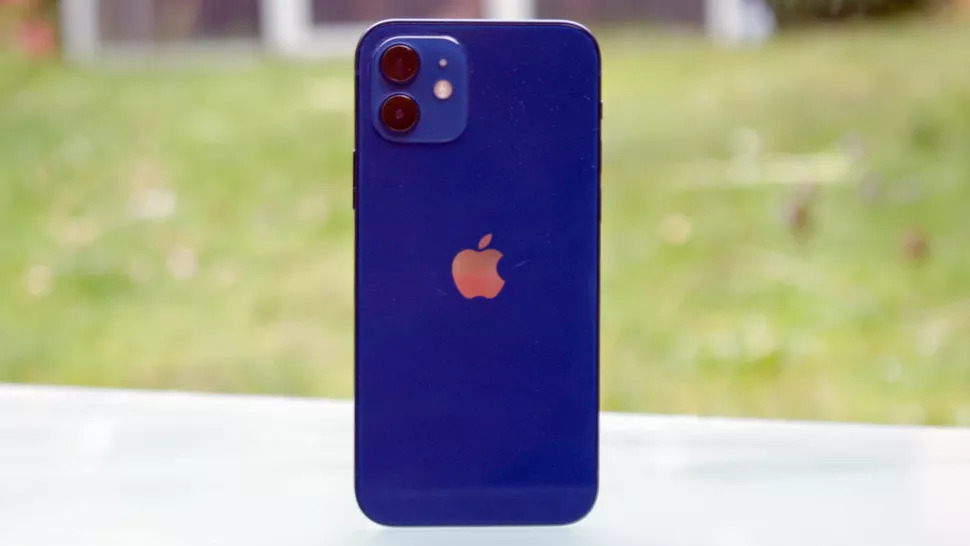
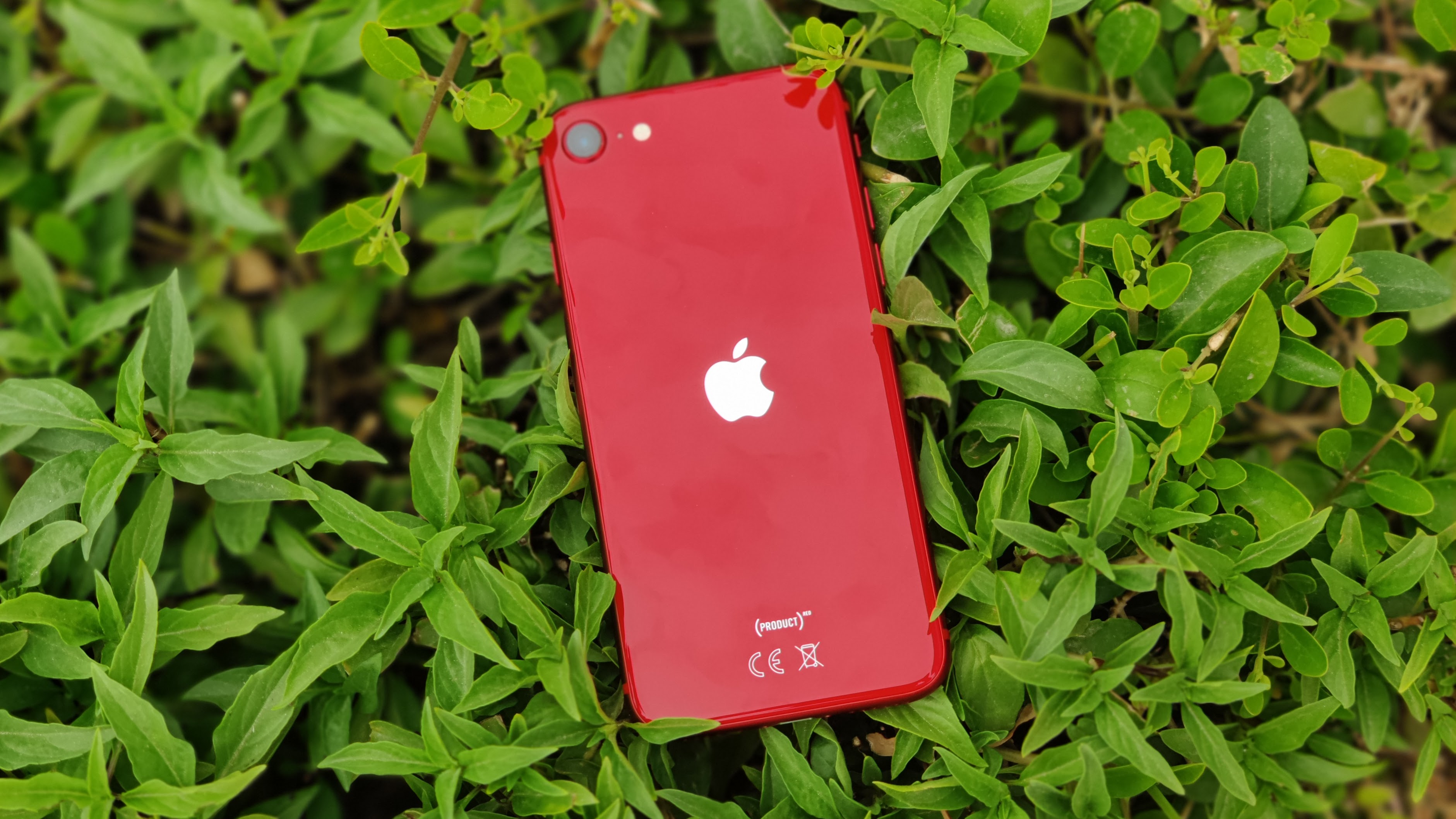
The iPhone 12 is an entirely different kettle of fish. At 146.7 x 71.5 x 7.4mm and 164g it’s bigger than the iPhone SE in every way. It’s proportionally taller, too, and its flat-edged industrial design comes from a completely different school of though. It’s more iPhone 5 than iPhone 6, but with a more modern twist.
Around front, the iPhone 12’s all-screen design pushes back the chunky bezels of the iPhone SE, with an 86% screen-to-body ratio compared to the SE’s 65.4%. This has necessitated the dropping of the iconic Touch ID-imbued Home button, with a Face ID notch eating into the top of the screen by way of a replacement.
Both biometric systems present fast, secure and reliable ways to unlock your phone and authenticate payments. But Touch ID feels freshly relevant in a mask-wearing world, where Face ID has come to struggle.
The iPhone 12 is the hardier phone of the two, with a toughened nano-crystalline Ceramic Shield up front for four times the screen protection. It also benefits from an IP68 rating, compared to the iPhone SE’s IP67 rating, which means it can be immersed in far deeper water without issue.
In a nutshell, the iPhone 12 design is much fresher than the tired old iPhone SE, but the latter phone is more comfortable to hold and to lug around. The old ones aren’t always the best, but they’re often more comfortable.
Display

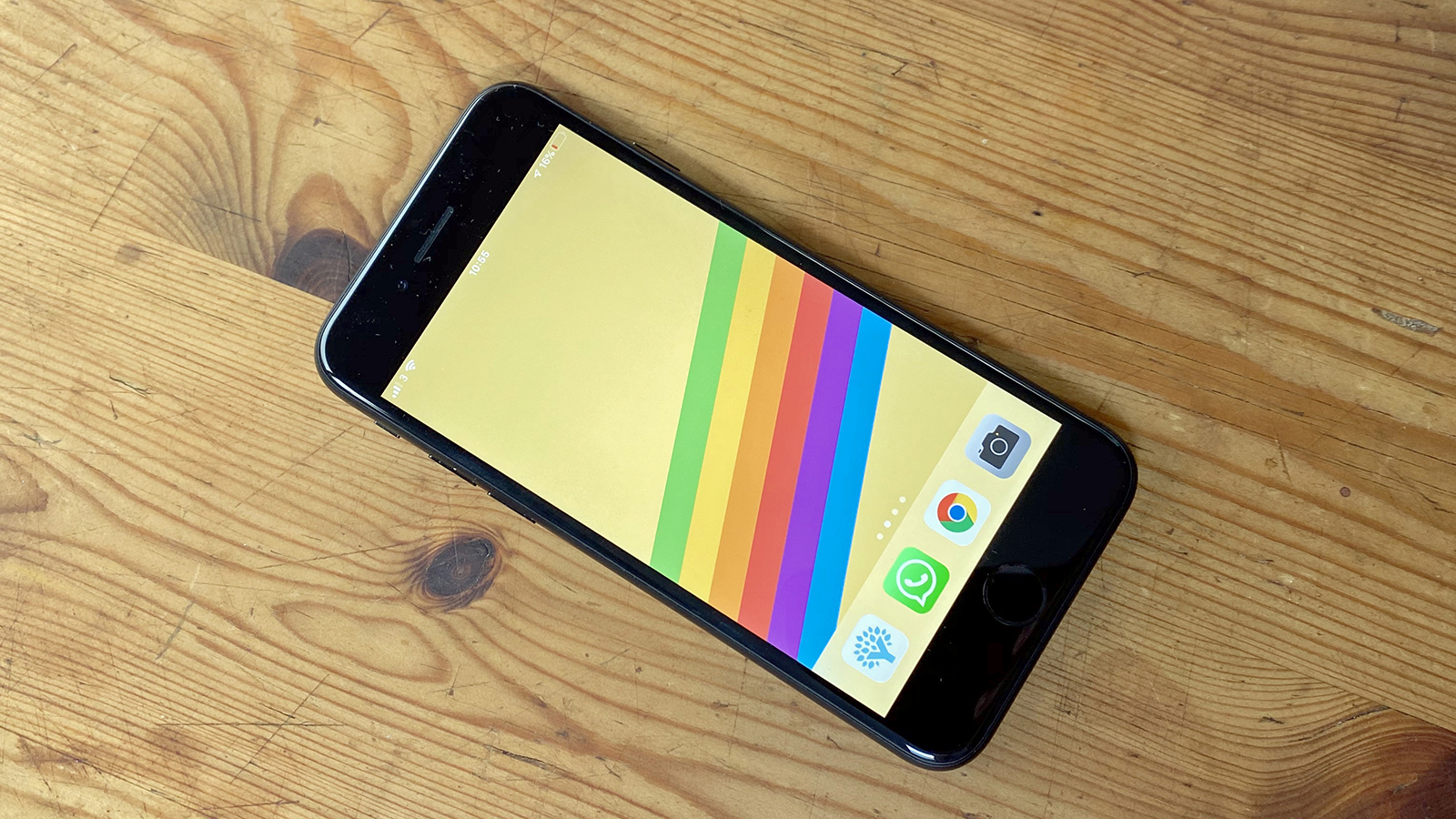
The reason the iPhone 12 is both bigger and proportionally longer than the iPhone SE (2020) is simple: its display is bigger and proportionally longer.
At 6.1-inches and 19.5:9, the iPhone 12’s display is way better suited to widescreen landscape content (i.e. videos and games) than the 4.7-inch 16:9 iPhone SE. You could make a case against the iPhone 12 for its intrusive notch, but it’s still giving you way more space to play with.
It’s not just a size thing either. The iPhone 12 screen is better than the iPhone SE’s in every way, with a higher 1170 x 2532 resolution (versus 750 x 1334) for a sharper 460 ppi pixel density (versus 326 ppi).
Beyond that, the iPhone 12 sees Apple switching to the OLED display panel technology that had previously been reserved for the more expensive iPhone X and Pro models. This yields much richer colors and deeper contrast than the iPhone SE’s dated IPS LCD technology. Although the latter does feature wide color gamut support, with the iPhone 12’s OLED display blacks are truly black, whereas LCD panels are invariably a dark shade of gray.
Just as with their respective designs, the iPhone SE display simply belongs to a different era to the iPhone 12’s. There really is no contest - unless, that is, the ability to use a screen with the thumb of your holding hand is a priority. But even then, you should probably consider the iPhone 12 mini, which is essentially the iPhone 12 shrunk down to a sub-iPhone SE size.
Let’s not get too carried away with the iPhone 12 display love-in though. It’s still only 60Hz, just the same as the iPhone SE (2020), whereas virtually every non-Apple phone at this price has moved on to 90Hz and 120Hz refresh rates.
Camera
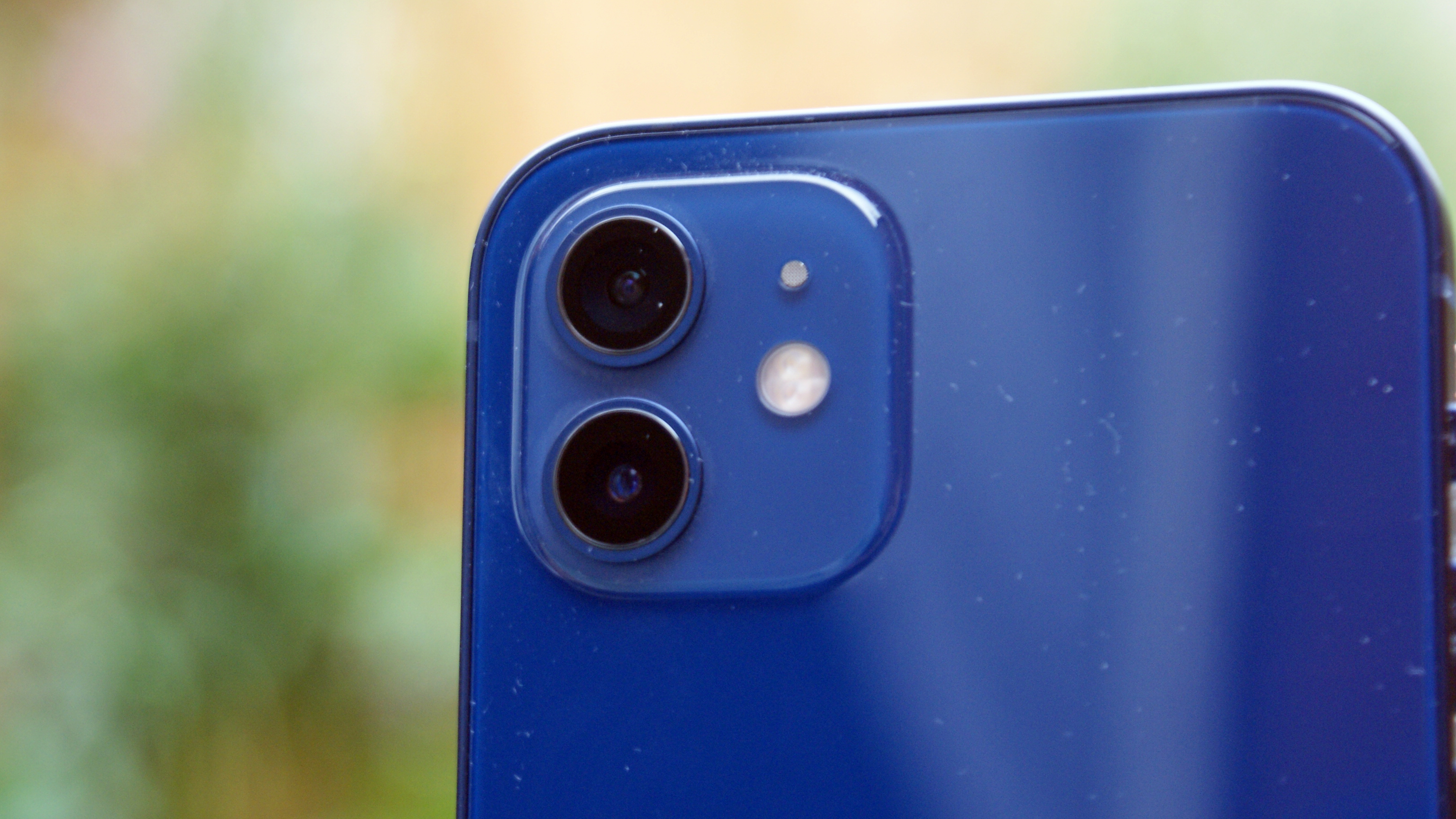
When it comes to smartphone photography, you typically get what you pay for. It’s no surprise, then, to learn that the iPhone 12’s camera is significantly superior to the iPhone SE’s.
That’s not to say that snaps taken with the iPhone SE (2020) underwhelm in any way. Short of the Google Pixel 4a, it’s just about the best photographic experience you’re likely to get for less than $400.
You can extend the iPhone SE’s iPhone 8 debit to include its camera hardware. You’re getting the exact same single 12-megapixel sensor and f/1.8 lens set-up.
That’s fine, though, because Apple’s major skill when it comes to photography has increasingly become its image processing technology. And on that front, the iPhone SE (2020) benefits from packing a relatively modern A13 Bionic SoC.
We’ll talk about the A13’s performance in due course, but in camera terms this chip enables the iPhone SE to take pictures that are way better than its modest hardware would suggest is possible. In good light, images are routinely crisp and balanced, while colors are nice and accurate. You’ll rarely whiff a shot with the iPhone SE.
Even so, the iPhone 12 camera is a notch or two above. It packs a dual-camera setup, with a 12-megapixel wide sensor allied to a fast f/1.6 lens. That’s backed by a 12-megapixel f/2.4 ultrawide, which simply enables you to take the kind of 120-degree ultrawide shots that the iPhone SE can’t even hope to emulate.
This dual sensor approach also fuels Apple’s famous Portrait mode, enabling you to make your subject really pop from the background. Props to the iPhone SE, though, for enabling this feature without a second sensor - again a tribute to Apple’s computational photography chops.
While the iPhone SE benefits from the A13 Bionic chip, the iPhone 12 features the even newer and more capable A14 Bionic. With its new image signal processor (ISP) powering such features as Smart HDR 3, it can pick out and render scenes with even richer colors and superior dynamic range.
But where the iPhone 12 really hammers its affordable bro is when the lights drop. Apple’s Night Mode is one of the best in the business, and here on the iPhone 12 it facilitates spookily bright and natural-looking shots in challenging lighting conditions. The iPhone SE can’t even get close, with the complete lack of a Night Mode to call its own putting paid to the phone as a viable low light companion.
Apple’s phones have been the best at capturing video for years, and both of these phones are impressive operators on this front. While both can shoot 4K/60fps video, however, only the iPhone 12 can shoot in Dolby Vision HDR, which makes footage look brighter and better exposed.
Specs and performance
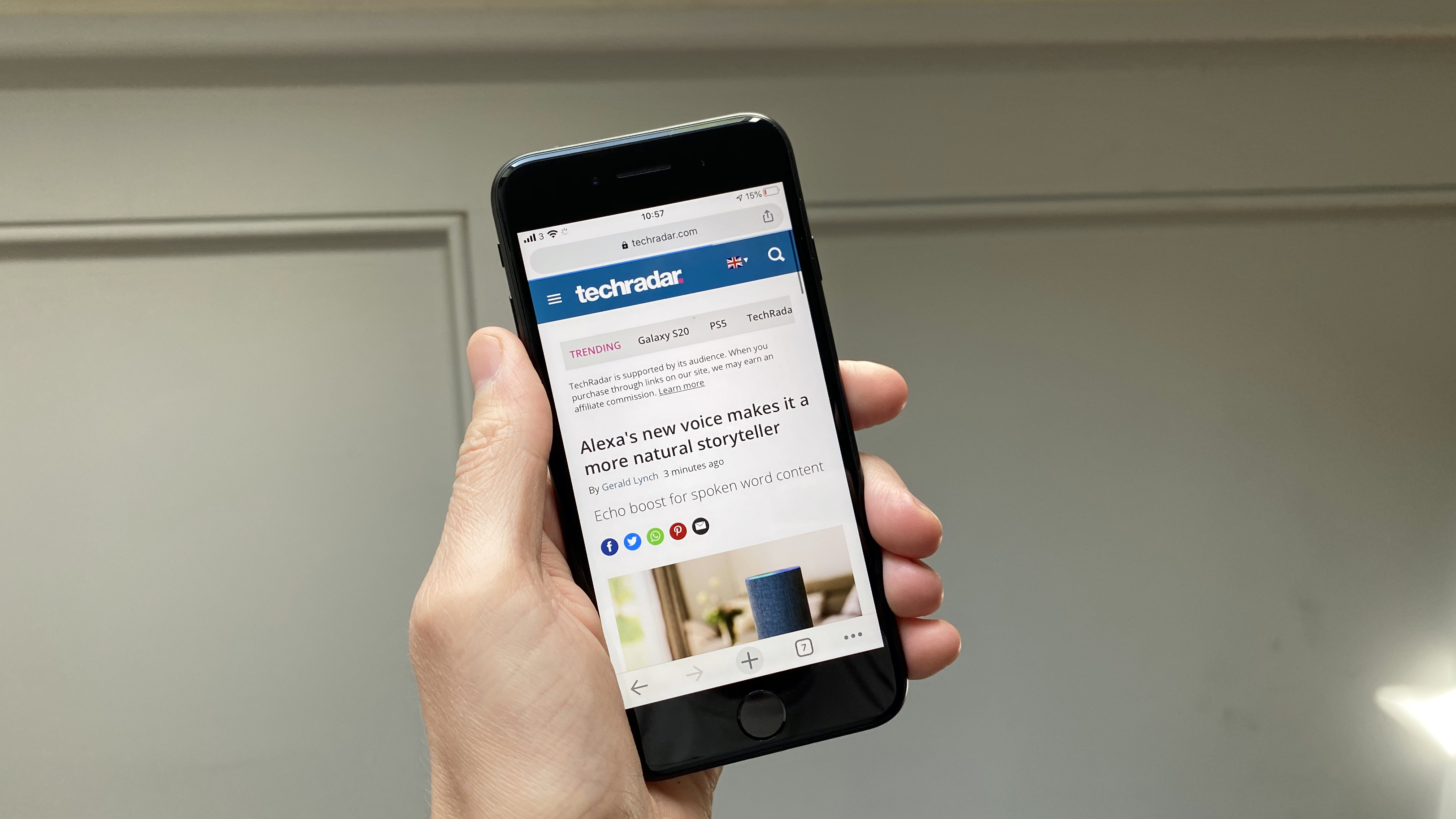
As we’ve just touched upon, the iPhone 12 runs on a newer, more up to date processor in the A14 Bionic. While the iPhone SE (2020)’s A13 Bionic is no slouch, it comes in second to the newer chip in every way.
Going by Apple’s claims and numerous benchmarks, the newer chip enjoys a roughly 20% boost across its CPU and GPU. The iPhone 12 also packs in 4GB of RAM as opposed to 3GB for the iPhone SE (2020).
What does this mean for the day to day performance of using these two phones? Not a lot, if we’re being honest. Apple’s phones are always superbly optimized, and they remain feeling fast for several years after release.
This means that the iPhone SE still feels snappy today, and you won’t experience a noticeable drop in performance in moving from one to the other. High-end games will run nigh-on flawlessly on both, with perhaps only the odd missing lighting effect or dropped frame in the latest and most demanding titles.
What the newer chip of the iPhone 12 really gains you - besides those additional camera tricks we mentioned above - is more time at the top. The iPhone 12 will feel faster for longer than the iPhone SE.
The A14 also features a new 16-core Neural Engine, which provides a considerable 80% boost to AI performance compared to its predecessor.
Another thing the iPhone 12’s A14 gains you is 5G connectivity. Apple made a lot of its latest phones being able to access 5G mobile networks, and if you live in an area that’s received the necessary infrastructure upgrade, you’ll be able to attain download and upload speeds well in excess of your average broadband connection.
One specification that’s disappointingly similar across these two phones is internal storage. Both base models provide a scant 64GB, while you can move up to 128GB and 256GB if you’re willing to pay the price. We can let that slide in the iPhone SE, but the newer and more expensive iPhone 12 should really be starting from 128GB.
Battery life
We wouldn’t pick either phone if we were after stamina as a matter of priority. But the iPhone 12 clearly has a big advantage when it comes to battery life. The newer phone packs in a 2815 mAh battery, which is considerably larger than the iPhone SE’s 1821 mAh equivalent.
As a result of this simple capacity advantage, as well as its more efficient A14 processor, the iPhone 12 will comfortably get through a day of moderate to heavy usage without having to plug into a wall socket. Under similar circumstances, the iPhone SE will be left gasping.
Light to moderate usage is where the iPhone SE is most comfortable. But even then, you won’t find yourself going to bed with half a tank of juice, which is quite possible with the iPhone 12 under a relatively light load.
Of course, the iPhone 12 isn’t perfect in this regard. Its own Achilles heel is network connectivity, where flicking between 4G and 5G is destined to bring that percentage down at a slightly concerning rate.
Both phones enable you to charge wirelessly, and in the case of the iPhone 12 that includes Apple’s new MagSafe standard. In practical terms this is a simple (if cool) magnetized take on wireless charging, similar to how the Apple Watch regains power.
The iPhone 12 also supports slightly faster 20W charging, whereas the iPhone SE is limited to 18W. You’ll have to buy those faster methods separately in both cases, however.
Takeaway
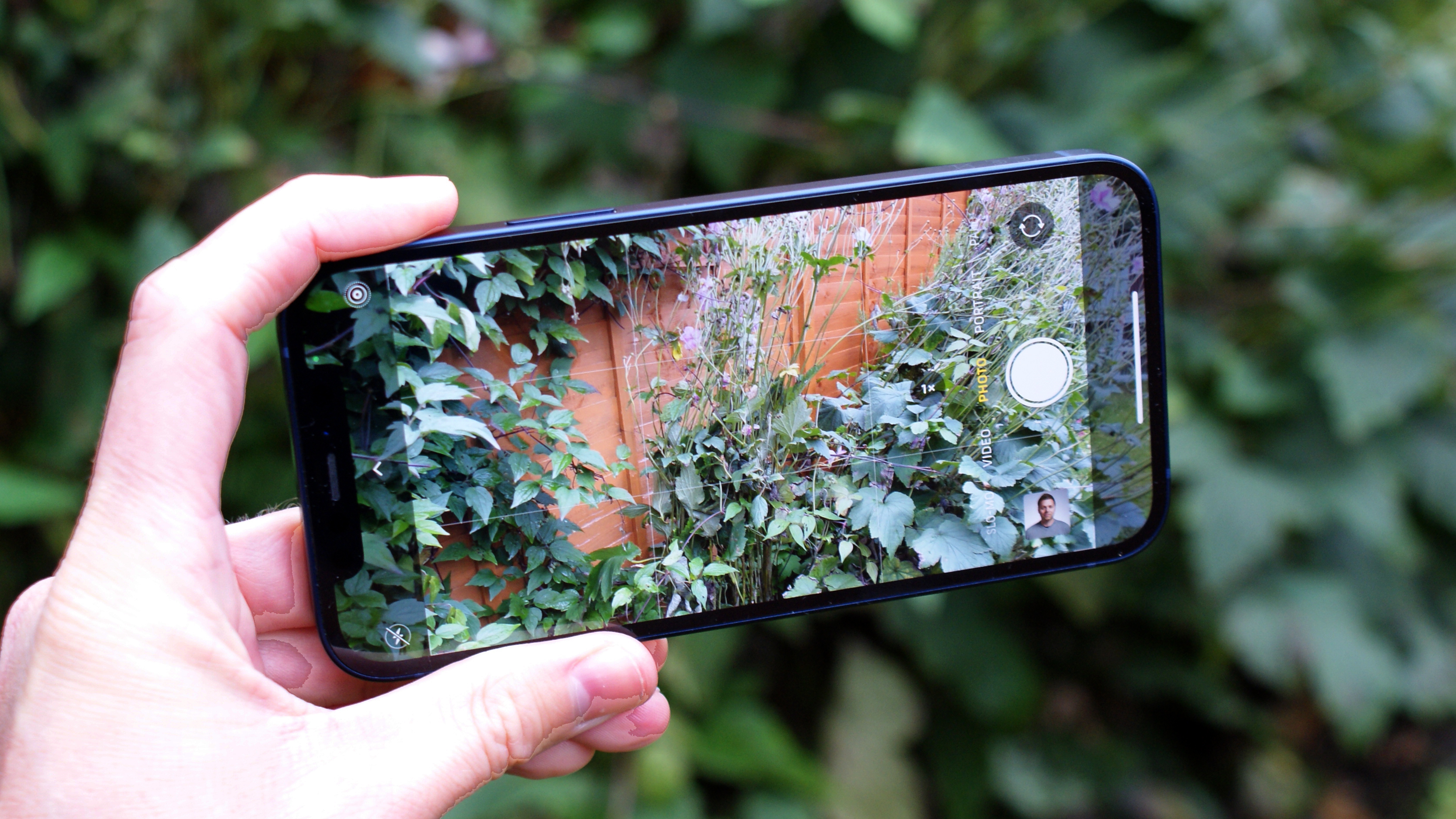
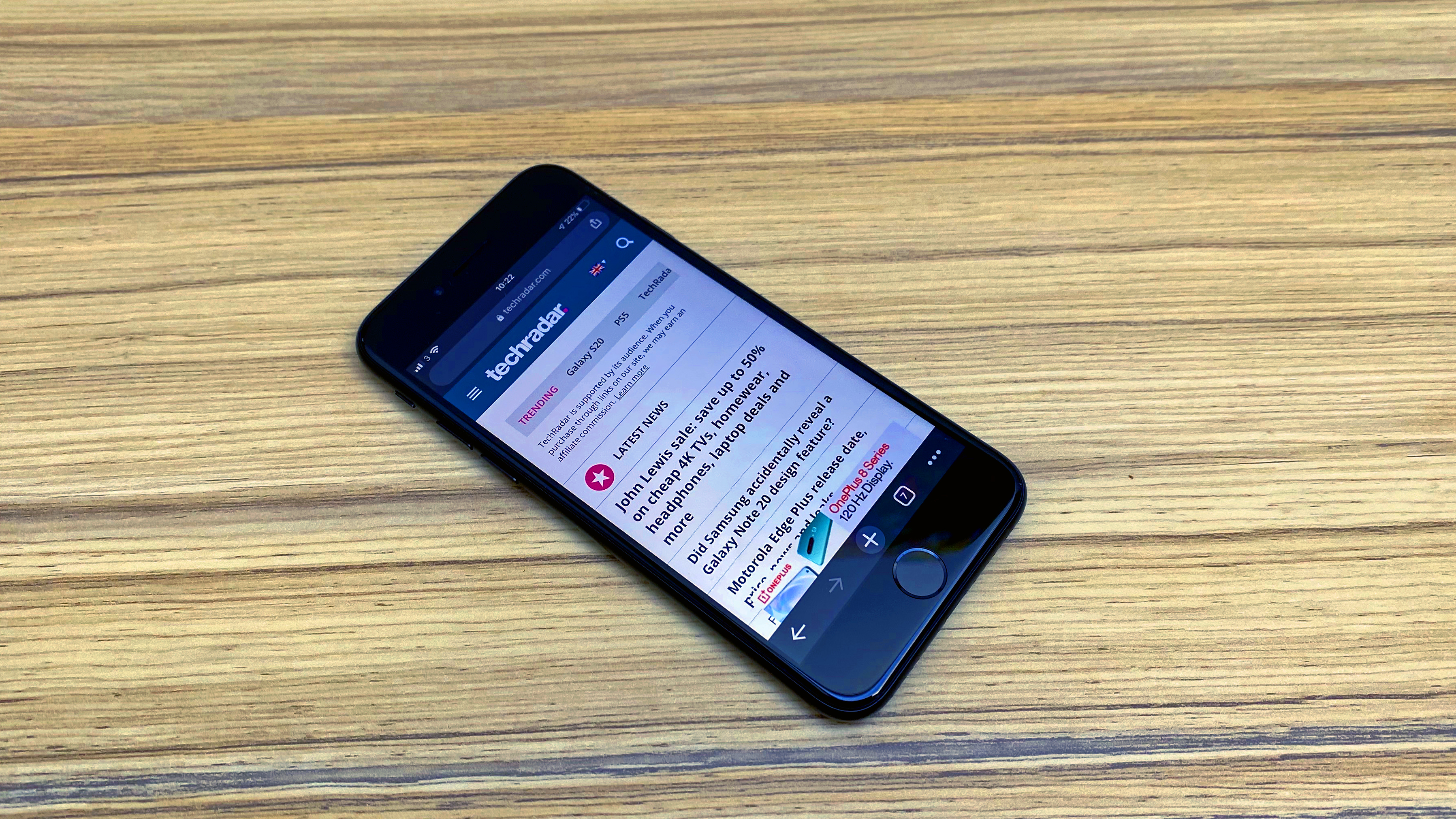
The iPhone SE remains the most affordable entry point to Apple’s esteemed smartphone line, and it continues to provide a premium-ish experience for not a lot of money. It’s fast and well built, and it sports features that are still uncommon for a phone under $400, such as a consistent camera and wireless charging.
On the other hand we have the iPhone 12, which is double the price and also superior in every way. Its design is fresher, its display sharper and more vibrant, and it takes better pictures - especially in low light.
We don’t think it’s as simple as saying you’re getting double the phone for double your money, though. Despite its parts bin approach, the iPhone SE remains excellent value, giving you an authentic Apple experience that doesn’t feel particularly compromised.
It’s also the preferable choice for those who prefer smaller phones - though if that’s the deciding factor for you, the iPhone 12 mini is a more appropriate comparison.
